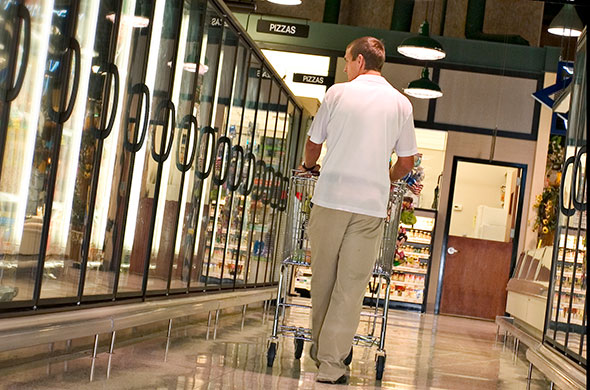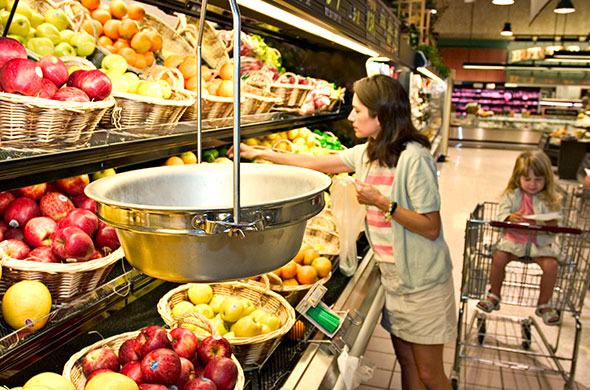
Enlace a la traduccion al espanol
Grocery Stores are playing essential roles in our lives. This was emphasized especially during Covid-19 Crisis. As people continued shopping for food at the stores or ordered on-line, Grocery Store sustainability gained additional importance. Grocery stores are responsible for approximately 9% of the total energy consumed by commercial buildings in the U.S. Energy efficiency is one of the very important components in a Grocery Stores’ sustainability. Energy-efficient Grocery Stores can also improve the comfort of their customers. For example, energy-efficient designs help to improve indoor air quality and thermal comfort.
Many Rural grocery stores, especially the small family operated businesses, may find it especially challenging to implement energy efficient practices and technologies because of their limited cash flow and labor availability. That is why the USDA is helping rural grocery stores become more sustainable through free energy audits and financial assistance with implementation. Food waste reduction and water conservation are also important ways to become more sustainable. This will help Rural grocery stores improve their bottom line and the environment.
Energy-efficient building systems also enable grocery stores to be better neighbors. For example, they reduce a store’s draw on the power grid, reducing the risk of power interruptions in the surrounding neighborhood. This includes limiting a store’s noise pollution and both indoor and outdoor lighting. A single large commercial freezer can use up to 38,000 kilowatt-hours of power annually—producing the equivalent annual greenhouse gas emissions of 5.5 vehicles—improving the energy efficiency of grocery stores can have a notable environmental impact. Lastly, a reduction in grocery store operating costs can also lead to lower and more consistent grocery prices for consumers.
To help grocery stores and all Americans reap these benefits, the Advanced Energy Design Guide for Grocery Stores offers guidance for achieving 50% energy savings compared to a standard grocery store. This guide shows how to achieve a healthy and inviting indoor environment, display merchandise effectively, avoid moisture intrusion, and optimize ventilation, while also cutting energy waste and running a successful business.
13 energy-saving refrigeration suggestions for grocery stores
The new federal energy efficient refrigeration guidelines present grocery store owners and managers with numerous opportunities to reduce refrigeration costs, maintain product integrity, save on manpower and maintenance, and present their products in a more flattering light. The trick is finding ways to take advantage of these opportunities3.
Here are some suggestions for grocery store owners and managers who want to meet the new federal guidelines while also saving money:
- Purchase ENERGY STAR-certified products. ENERGY STAR is a program designed and implemented by the Environmental Protection Agency. It evaluates and rates products on their energy efficiency. High-efficiency grocery store refrigerators and freezers that are ENERY STAR-certified are approximately 30% more efficient than standard models4.
- Replace existing refrigerators and freezers with high-efficiency grocery store refrigerators and freezers. Refrigeration can account for up to 40% of the energy consumption in a typical grocery store, making it a prime area for cutting costs. As with many energy efficient refrigeration products, PG&E offers its customers several rebates and incentives for installation. A full list of the products that qualify can be found in PG&E’s Refrigeration Rebate Catalog5. It’s important to note that appliances that the U.S. Department of Energy refer to as a refrigerator or freezer is often called a display case.
- Install anti-sweat heater (ASH) controls. Equip display refrigerators with ASH controls that sense the relative humidity in the air around the display case and reduce the amount of power supplied to the heaters accordingly.
- Add auto-closers to walk-ins. Applied to the main insulated door of a walk-in cooler or freezer, auto-closers reduce energy waste by ensuring that doors are sealed tight.
- Effectively manage energy with evaporator fan controllers. When the compressor in a walk-in cooler or freezer cycles off, evaporator fan controllers reduce fan motor power by at least 75%, thus saving energy and money.
- Switch to newer, more efficient refrigeration display cases. New high-efficiency, low-temperature remote display cases are super-efficient. They are especially useful for storing items like beverages and deli products that customers often select themselves, as they offer a more pleasing view of those products.
- Add night covers for display cases. Night covers are installed on display cases overnight to decrease cooling loads during off hours.
- Install light-emitting diode (LED) bulbs in display cases. LEDs perform better in cold temperatures, produce less heat output and show off products in a more flattering light, leading to less spoilage, lower utility bills and higher sales.
- Install motion sensors on case lighting systems. Why leave case lighting on when no one is around? Motion sensors save money and energy by cycling lights off when customers aren’t in the area.
- Regularly clean cooling coils. Regular cleaning of cooling coils improves heat transfer within the system, which is a key to running an energy efficient refrigeration system.
- Check temperature settings. Freezers should be kept between -14 and -8 degrees Fahrenheit, and refrigerators between 35 and 38 degrees Fahrenheit. Temperature settings outside those norms will likely lead to wasted energy6.
- Check door seal integrity and keep doors closed as much as possible. By keeping doors shut as often and as tight as possible, grocery store owners and managers can reduce energy waste in a relatively simple way that requires only a bit of employee education and training.
- Properly maintain equipment. Work closely with a contractor who is experienced in installing and maintaining energy efficient refrigeration equipment. Without proper equipment maintenance, energy efficient products and the benefits they bring, can be mitigated or eliminated.
Sources
- Design Guide to Help Grocery Stores Cut Energy Use | Department of Energy
- 13 Ways Grocery Stores Can Meet Evolving Energy Efficiency Standards
- Energy Efficiency Standards for Commercial Refrigeration Equipment
- Benefits of Energy Star Certified Commercial Food Service Equipment
- Energy Savings Tips for Small Businesses: Grocery and Convenience Stores
- Rebates and Incentives for your Business
Resources
- Energy Savings Tips for Small Businesses: Grocery and Convenience Stores
- An Overview of Energy Use and Energy Efficiency Opportunities
- The Latest on How Retailers Are Focusing on Sustainability (supermarketnews.com)
- Pandemic shopping behaviors that will stick — and those that won’t (supermarketnews.com)
- 3 Shocking Grocery Store Food Waste Statistics | Dumpsters.com
- Unsold Food From Amazon Go Was Found In A Seattle Landfill (buzzfeednews.com)


